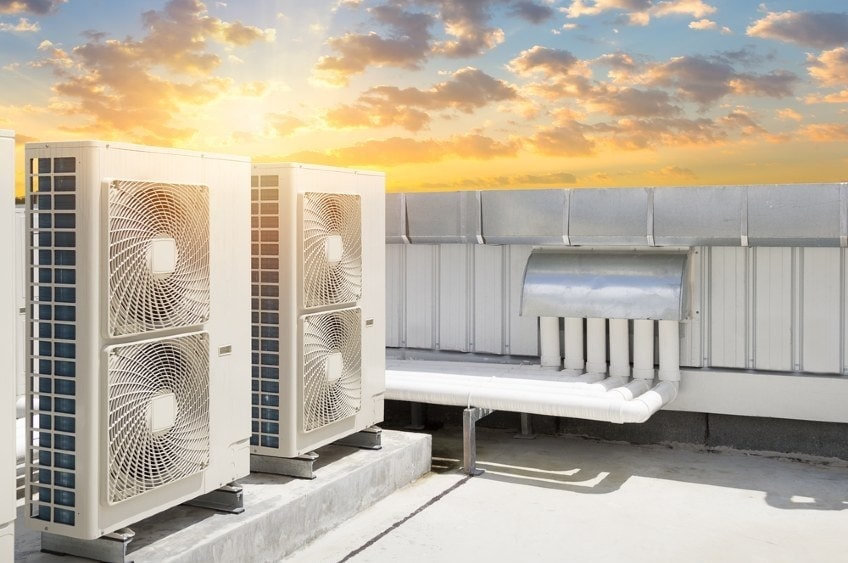
These uncertain times have required everything and everyone around us to adapt to a new normal. Due to the pandemic, the Centers for Disease Control & Prevention (CDC) offer various recommendations and guidelines that should be followed in an effort to stop the spread of COVID-19. To comply with these guidelines, property managers and building owners have not only had to limit the number of people into their space, but they have also had to adjust the way their HVAC systems operate, ultimately impacting both occupant comfort and energy bills. Property managers and building owners acutely felt this pain point over the summer as cooling costs soared, and they will experience the opposite — but equally uncomfortable and costly — effects during the winter months. As a result, architects and engineers are tasked with solving an unprecedented energy efficiency challenge.
Ventilation & COVID-19
The CDC states that when it comes to the risk of contracting COVID-19, indoor spaces are riskier than outdoor spaces due to less ventilation. Generally speaking, the ventilation rate should be based on the number of people occupying the space. Therefore, high traffic areas need extra ventilation. According to the Environmental Protection Agency (EPA), increasing the ventilation of a space lowers the concentration of indoor air pollutants. Additionally, increasing ventilation can also limit exposure to the products used to clean and disinfect surfaces. Opening windows and doors will further improve indoor air quality and airflow.
Another method for improving ventilation of a building is reducing the amount of air that is recirculated throughout the space. Prior to the pandemic, recirculating a large percentage of room-temperature air was common practice in facilities management. However, the CDC has now recommended eliminating air recirculation in office buildings and other commercial spaces. While windows and doors can be opened and HVAC systems can be adjusted for improved filtration and ventilation, these changes come with a steep price.
The Problem: Lower Energy Efficiency & Higher Energy Bills
While opening windows and doors and improving the ventilation of a commercial space can help lower the risk of COVID-19 exposure, it can also drive up energy bills and lower energy efficiency. If an HVAC system is running, but windows and doors are open, this can cause excessive wear and tear on the unit. Not to mention, while attempting to maintain the desired indoor temperature, the HVAC system will use an excessive amount of energy, driving up energy bills and driving down the efficiency of the commercial building.
Eliminating air recirculation also strains a building’s HVAC system. Recirculating room-temperature air requires far less energy than pulling in outdoor air that must be heated or cooled to the desired temperature.
This additional wear and tear can shorten the lifespan of an HVAC system, resulting in the need for premature replacement or repair. While it is of the utmost importance that property managers and building owners pivot their operations to meet CDC guidelines and suggestions, it’s critical that your client’s commercial space is equipped to maximize energy-efficiency and protect its HVAC systems.

Utilize Window Film to Preserve HVAC Systems & Maximize Energy Efficiency
As a result of these recent changes in air ventilation guidelines, architects and engineers are presented with the challenge of maintaining the energy efficiency of buildings without compromising sanitation and occupant health. A potential solution to this challenge is 3M Insulating Window Film.
3M Insulating Window Film improves energy efficiency and adds to the life of HVAC systems by helping to regulate indoor temperatures. Whether your primary concern is solar radiation through the windows creating hot spots, or heat escaping through the windows in the winter, window film can combat these issues. In addition to improving the energy efficiency of buildings, the film can lengthen the lifespan of HVAC systems. Down the road, this will not only save your client money on energy bills, but it will also reduce the need to repair or replace HVAC systems as often.
While changes in ventilation to combat the spread of COVID-19 will undoubtedly impose a negative effect on energy inefficiency, architects and engineers can mitigate these energy efficiency challenges by specifying 3M Insulating Window Film for their clients’ projects.

Energy Products Distribution is a Master Distributor of 3M Window Films, 3M Paint Protection Films, 3M Wrap Film Series 2080, 3M Protection Wrap Films, 3M Architectural Finishes, 3M Ceramic Coatings, and Windshield Skin. We sell our products to professional installers throughout the US who provide turnkey installations (labor and material) to end-users in the automotive, commercial, government, and residential markets. Contact us to learn more about the benefits of these products.









